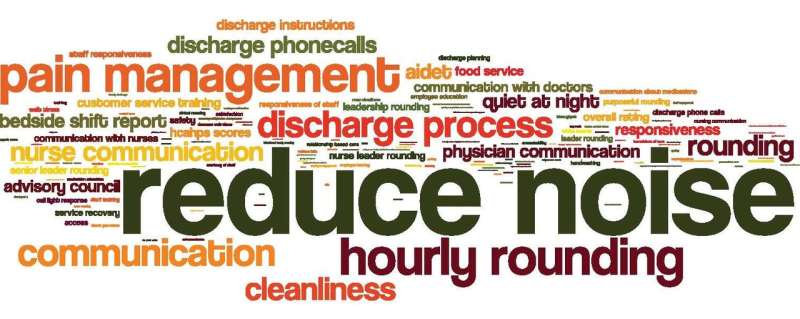Alarming amounts of noise demand ways to silence noisy hospital environments

Spending a night in the hospital is not only stressful, but also loud. The constant beeps, whirrs and alarms ascend to a cacophony that produces anything but a relaxing, restful environment. Ilene Busch-Vishniac, of BeoGrin Consulting in Baltimore, Maryland, will summarize the limited number of studies available on hospital noise and discuss the different approaches health care facilities are taking to bring restful repose to patients across the country.
According to the Hospital Consumer Assessment of Healthcare Providers and Systems (HCAHPS) survey, noise is the top complaint of patients, staff and visitors. "Nearly everyone has a stay in a hospital at some point," Busch-Vishniac said. "Noise is a universal problem in hospitals around the world."
Busch-Vishniac will explore these concepts during the 174th Meeting of the Acoustical Society of America, being held Dec. 4-8, 2017, in New Orleans, Louisiana. Noises emanate from a variety of sources at the bedside. Airflow and the noisy machines controlling it are kept on high to prevent pathogens from lingering near patients, and overhead pages alert staff of needs or announcements. Equipment alarms are the most egregious source, and although they are designed to alert staff of changes in the patient's medical condition, many also sound when medication needs to be changed or when battery conditions are low.
"Alarms in hospitals are being horribly abused," Busch-Vishniac said. "Most of the time, they don't in fact indicate urgent situations."
Previous studies showed that alarms at a patient's bedside sound an average 133 times per day. With so many alarms, staff often face alarm fatigue as well.
"Most alarms are being responded to eventually, but not all in a timely fashion," said Busch-Vishniac. "Staff also may not respond quickly because they recognize that the sound is not critical and the situation will right itself."
Besides the obvious barrier to rest, high noise levels have been associated with changes in the patient's heart rate, respiration and blood pressure. These changes increase stress levels and may impair healing. The noise can also impair communication between patients and staff.
With noise levels on the rise, the Centers for Medicare and Medicaid Services (CMS) initiated the HCAHPS survey in 2008 to assess consumer perception of health care providers and systems. Today, more than 5,500 hospitals contribute to the report, which consists of patients' responses on seven composite measures, including questions focused on room cleanliness and quietness.
The survey has teeth. Hospital value-based purchasing links up to 30 percent of CMS payments to hospitals across the country to the results of the survey.
"Faced with a loss of money, many hospitals are looking for ways to address noise levels in a way that patients can see as an improvement," said Busch-Vishniac.
Hospitals have been developing and implementing noise control programs that can be broken into two categories: engineering and administrative interventions.
Engineering interventions aim to find ways to quiet the room. The solutions can be as simple as closing the door to a patient's room or as complex as installing acoustical absorption materials along the walls and ceiling to dampen the noise level. Administrative interventions focus on changing behaviors. Many hospitals have instituted quiet hours when doors are closed and voices are kept low.
One of the big changes during the past 10 years has shifted alarms from solely sounding at the patient's bedside to also alerting a central monitor at the nursing station. This approach improves the ability of staff to identify and respond to alarms set at a reduced volume.
According to Busch-Vishniac, it may be possible in the future to remove alarms from the bedside. A quiet hospital may not be a pipedream for much longer.
More information: Presentation 3pIDa: "Hospital noise: how bad is it?" by Ilene Busch-Vishniac, Wednesday, Dec. 6, 2017, in Salon E in the New Orleans Marriott. asa2017fall.abstractcentral.com/s/u/M8hKSrQu66E
















